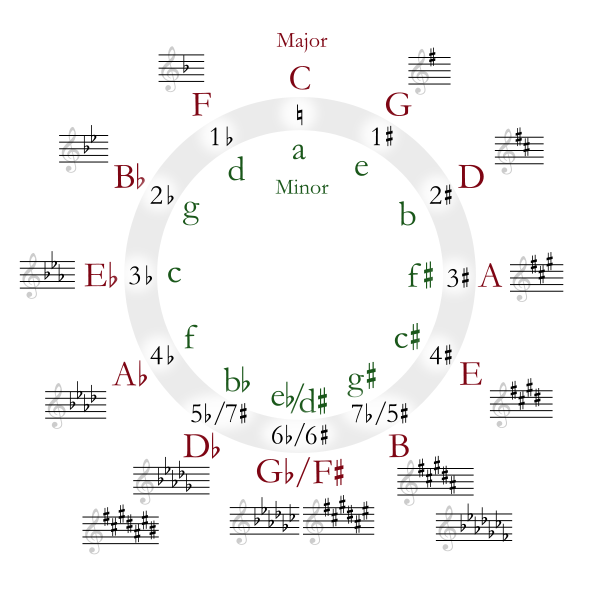Key Signatures: A Useful Tool, Not Just Music Theory Dogma
Key signatures are an invaluable piece of information in music. They denote which pitches will be used for a song.
So What's a Key?
Music is generally played in a particular tonality or key. So what does that mean? If we play a song in the "key" of D, then that whole song will be based around a D note, or a D chord. The song will have a particular "D" sound to it. That is because it uses the notes from a D scale. This tonality or key is represented by the key signature.
At the beginning of each line in written music is a grouping of either sharps for flats that tells us the key. This chart shows which ones go with which keys. Note: A key will be either sharp of flat; it will never have both.

Order of Sharps and Flats
When we progress around the circle, we are adding or removing one sharp at a time or one flat at a time. Here is the order in which these will be added.
Order of Sharps: F C G D A E BOrder of Flats: B E A D G C F
So when you see a song with one sharp it's going to be an F# every time. If you see 2 sharps, they are F# and C#. If you see 5 sharps, they are F# C# G# D# and A#.
If you see a song with 1 flat, it's a Bb. If you see a song with 2 flats, they are Bb and Eb. If you see 5 flats they are Bb Eb Ab Db & Gb.
Identifying Keys
Once you count the sharps or flats, you can find what key it is on the chart. However, you won't always have the chart with you, so here's a trick to help. If it's a sharp key, look at the last sharp and go up a half step and there is your key. So if you see an F# and a C#, take the last one (C#) and go up a half step to D and there it is. If it's a flat key, look at the second to last flat and there is your key. So if you see a Bb, Eb, and and Ab; look at the second to last one (Eb) and there you have it.
Using These
So how can we use these key signatures? When we play in a particular key, we'll be using the notes from that scale. Here's a way you can see which notes those are. If you see a song in 4 sharps, you can either use the chart or the above tip to figure out that it's E. Then you write the alphabet from E to E:
E F G A B C D E
then go back and fill in the sharps in the key signature:
E F# G# A B C# D# E
and there you have it. These are the main notes the song will use.
Accidentals
A song might use notes other than these. When this happens, (such as using a D natural in the E example above) a natural sign will be placed next to that particular note in the music to show that it is not sharp. We call this an accidental. This D will remain natural until the next measure.
That's pretty much it for key signatures. While they are a useful tool, don't worry about them too much, the more you use them, the easier they get. The best way to use these is to memorize how many sharps or flats go with each key and memorize what sharps or flats they are. (Remember they will always be in the same order.)
Return from Key Signatures to Basic Music Theory
Return from Key Signatures to Homepage
Hope this helps! Practice hard and let me know if you have any questions!